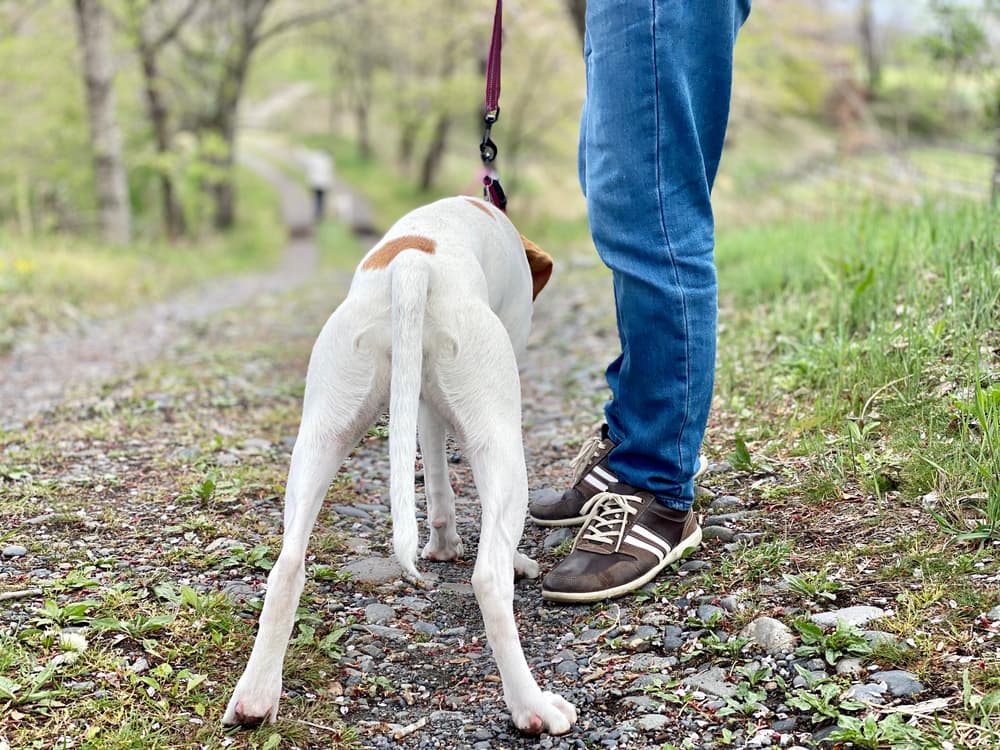Limber Tail Syndrome in Dogs

Despite first being described and referenced in 1997, there’s still a lot we don’t know about limber tail syndrome in dogs – an infrequent issue where a dog’s tail goes limp and painful. It’s also known as swimmer’s tail, rudder tail, limp tail, staved tail, cold tail, and drop tail, although the official term for it is acute caudal myopathy.
Early estimates of the frequency of limp tail in dogs found it affected 1 in 200 working dogs, and it’s thought to be less common in dogs that are not working breeds. However, a more recent study in Labradors found that, on average, 1 in 10 dogs had a case of limp tail. It’s obviously a lot more common than previously thought, probably because – thanks to its low severity – most dogs will recover quickly and may never see a vet for the condition.
What Is Limber Tail in Dogs?
Limber tail syndrome in dogs (acute caudal myopathy) is a condition characterized by a painful and limp tail. It goes by a number of other names, the most common of which are “swimmer’s tail” and “cold tail.”
Luckily, limber tail is not considered a serious condition – on average, dogs recover within 3 days, although some take over a week to feel better.
Limber tail is not thought to be a common condition in the general dog population. However, it is around five times more common in working dogs (especially gun dogs such as Retrievers and Pointers) and in higher latitudes, meaning in some northern areas with a rural population it may be quite common. It also seems to have some sort of genetic basis, appearing in certain breeding lines more often. Some dogs seem to be prone to limber tail syndrome and will be affected by repeated episodes.
How Do Dogs Get Limber Tail?

It is not known exactly what causes limber tail syndrome in dogs, but the signs and the way the condition develops suddenly are thought to be related to overworked muscles – in other words, a sprained tail.
Here are some activities and conditions that may cause limber tail in dogs.
Swimming
Swimming is one of the most common causes of limp tail in dogs (hence the terms “swimmer’s tail” and “rudder tail”). Dogs that swim are about five times more likely to have a case than non-swimmers. It is not clear whether the exposure to the cold water or the actual act of swimming causes a dog’s tail to be limp after swimming. However, it seems likely that overuse of the tail muscles while swimming (dogs use their tails like a rudder) could cause a painful, sore tail for a few days afterwards. Having said that, some cases happen after immersion in cold water and it’s possible the cold water itself is a contributing factor.
Vigorous Exercise
Vigorous exercise is also thought to be a contributing factor to limp tail syndrome. Again, this makes sense if we accept that limp tail in dogs is caused by painful, overworked muscles.
Cold or Wet Weather
Anecdotally, cold or wet weather may increase the chances of a dog suffering with limp tail. In this study, a few cases occurred without swimming but in cold or wet weather, showing that swimming isn’t the only cause of limp tail. However, most of these cases had also had vigorous exercise, making it difficult to know the exact cause of the problem.
Confinement
A few cases of limber tail seem to happen after confinement such as in a crate or car. It’s not clear how this would cause limber tail, but may be as a result of ‘stiffening up.’ It could be that the confinement itself wasn’t related to the development of limber tail – in this study, all of the cases that had limber tail after confinement had also been swimming, had vigorous exercise, or been exposed to cold weather.
Hypothyroidism
There is one case of a dog with hypothyroidism developing signs consistent with limber tail. It’s likely that this was unrelated, but since no other studies into this have been done it’s possible that there is a connection.
Symptoms of Limber Tail Syndrome
Limber tail syndrome is usually diagnosed based on symptoms alone, as they are quite distinctive.
Dogs with limber tail have a limp or droopy (flaccid) tail, which may be completely droopy or may stick out straight behind them for a few inches before drooping. The tail base is usually very painful, which may make dogs aggressive or even constipated as they try to avoid using their tail muscles for pooping.
Other symptoms of limber tail syndrome in dogs include:
- Limp, droopy, or flaccid tail
- Stiff tail base
- Painful tail base
- Unusual posture (related to pain)
- Reluctance to sit or squat
- Aggression (likely related to pain)
- Constipation (usually due to reluctance to squat)
- Erect hair at tail base
- Staggering gait
How to Diagnose Limber Tail in Dogs

In most dogs, the combination of a painful, stiff tail base and limp length of tail is enough to diagnose the condition – especially in a working breed or if the dog was previously swimming.
Your vet will feel (palpate) your dog’s tail to confirm the tail pain and also to feel for swelling related to an injury such as a bruise or fracture.
While a clinical exam is usually sufficient for your veterinarian to diagnose your dog with limber tail, they may recommend further tests if they aren’t sure. This may involve blood tests and X-rays to check for a broken bone, which would cause similar signs.
Another commonly mistaken condition is anal gland problems – your vet may examine your dog’s anal glands and empty them in case this is causing their symptoms.
Limber Tail Treatment
While limber tail does resolve on its own without treatment, it’s a painful condition. Most veterinarians will recommend giving your dog some pain relief in order to make their recovery faster and more pleasant. In most cases, anti-inflammatory NSAIDs are all that is necessary to treat dogs with limber tail syndrome.
Pain medication should be combined with rest (but not close confinement such as in a crate, which could make it worse) and being kept warm and dry.
You may be wondering: how long does limber tail last? On average, limber tail syndrome in dogs lasts around 3-4 days, although it ranges from a few hours to 10 days.
Natural anti-inflammatories and home remedies for limber tail in dogs are not sufficient to relieve pain and keep your dog comfortable.
Medications for Limber Tail in Dogs
In general, NSAIDs (Non-Steroidal Anti-Inflammatory Drugs) are the most common drug used to treat limber tail in dogs. Common NSAIDs prescribed to dogs for limp tail include:
- Meloxicam (brand names Metacam, Loxicom)
- Carprofen (brand name Rimadyl)
- Firocoxib (brand name Previcox)
- Deracoxib (brand name Deramaxx)
General Cost for Limber Tail Treatment
Limber tail is not generally considered an expensive condition to treat. In most cases, an examination and a week’s worth of NSAIDs is all that is required. This is likely to cost $50-$150 depending on your veterinarian and the size of your dog.
In more unusual cases where further investigations, more medications, or follow-up exams are required, the fee may rise to $500. If you have budget constraints it’s important to communicate these to your veterinarian as soon as possible, as they can adjust their investigations and treatment plan to help you stay within budget.
How to Prevent Limber Tail in Dogs
Since the cause of limber tail isn’t fully understood, it’s difficult to prevent swimmer’s tail in dogs. For most pet dogs, limber tail is unlikely, and prevention isn’t necessary.
However, taking a few sensible precautions can possibly help prevent this condition:
- Build up fitness slowly and avoid strenuous physical activity until your dog is conditioned and ready.
- Avoid immersion in cold water when possible. This may mean changing your walking route for a few months if you have an at-risk dog.
- Avoid vigorous exercise in cold or wet weather, especially if your dog isn’t used to it.
- Avoid confinement in small crates – ensure your dog has space to stretch out comfortably.









